Analysis of Flood Water Level Variation in the Yichang–Chenglingji Reach of the Yangtze River after Three Gorges Project Operation
Abstract
:1. Introduction
2. Methods and Data
2.1. Study Area
2.2. Data
2.3. Methodology
2.3.1. 1D Channel Network Mathematical Model
2.3.2. Calculation of the Influencing Factors
3. Results and Analysis
3.1. River Network Modelling
3.2. Analysis of Riverbed Scouring
3.3. Analysis of River Resistance
3.3.1. Riverbed Sediment Coarsening
3.3.2. Beach-Channel Elevation Difference
3.3.3. Bottomland Vegetation
3.4. Analysis of the Backwater
3.4.1. Occurrence of Floods in Dongting Lake and the Mainstream of the Yangtze River
3.4.2. Backwater Height ΔZ
3.4.3. Backwater Influence Range L
4. Discussion
5. Conclusions
- (1)
- Since the backwater effect decreased gradually with upstream distance increments, a positive correlation existed between the backwater height ΔZ and outflow intensity T at the Chenglingji station in the YCR. Moreover, the backwater influence range L in the YCR correlated positively with T. Thus, given the extreme condition that simultaneous floods occur in the mainstream and Dongting Lake, these influences could extend upstream to Shashi in the YCR.
- (2)
- Because of the riverbed scouring and trenching processes, the decreasing flood levels in the YCR were mainly due to the increase in riverbed resistance caused by bottomland vegetation development and river channel morphology variations. The high water level caused by bottomland vegetation development and river channel morphology variation can basically offset the flood level decrease caused by topographic scouring and trenching. Moreover, the influence of the backwater of Dongting Lake on flood levels was relatively concentrated in local areas.
Author Contributions
Funding
Data Availability Statement
Acknowledgments
Conflicts of Interest
References
- Chen, Z.; Li, J.; Shen, H.; Wang, Z. Yangtze River of China: Historical analysis of discharge variability and sediment flux. Geomorphology 2001, 41, 77–91. [Google Scholar] [CrossRef]
- Zhang, J.; Zhang, Z.F.; Liu, S.M.; Wu, Y.; Xiong, H.; Chen, H.T. Human impacts on the large world rivers: Would the changjiang (yangtze river) be an illustration? Glob. Biogeochem. Cycles 1999, 13, 1099–1105. [Google Scholar] [CrossRef]
- Hu, B.; Yang, Z.; Wang, H.; Sun, X.; Bi, N.; Li, G. Sedimentation in the Three Gorges Dam and the future trend of Changjiang (Yangtze River) sediment flux to the sea. Hydrol. Earth Syst. Sci. 2009, 13, 2253–2264. [Google Scholar]
- Gao, Z.; Long, D.; Tang, G.; Zeng, C.; Huang, J.; Hong, Y. Assessing the potential of satellite-based precipitation estimates for flood frequency analysis in ungauged or poorly gauged tributaries of China’s Yangtze River basin. J. Hydrol. 2017, 550, 478–496. [Google Scholar] [CrossRef]
- Fang, H.; Han, D.; He, G.; Chen, M. Flood management selections for the Yangtze River midstream after the Three Gorges Project operation. J. Hydrol. 2012, 432, 1–11. [Google Scholar] [CrossRef]
- Liu, L.; Sun, W.; Liu, J. Spatio-Temporal Analysis of Simulated Summer Extreme Precipitation Events under RCP4.5 Scenario in the Middle and Lower Reaches of the Yangtze River Basin. Sustainability 2023, 15, 9218. [Google Scholar] [CrossRef]
- Shankman, D.; Lai, X. Severe flood probability on the middle Changjiang (Yangtze River) after completion of the Three Gorges Dam. Front. Earth Sci. 2022, 10, 1006004. [Google Scholar] [CrossRef]
- Lan, L.; Xu, Y.; Mei, Y.; Ren, Y.; Tian, Y.; Zhang, X. Optimized flood control for the Three Gorges Reservoir considering evolving flood propagation trends in the Jingjiang Reach of the Yangtze River. Front. Earth Sci. 2022, 10, 1013583. [Google Scholar] [CrossRef]
- Liu, P.; Li, L.; Guo, S.; Xiong, L.; Zhang, W.; Zhang, J.; Xu, C. Optimal design of seasonal flood limited water levels and its application for the Three Gorges Reservoir. J. Hydrol. 2015, 527, 1045–1053. [Google Scholar] [CrossRef]
- Mei, X.; Dai, Z.; Darby, S.E.; Gao, S.; Wang, J.; Jiang, W. Modulation of Extreme Flood Levels by Impoundment Significantly Offset by Floodplain Loss Downstream of the Three Gorges Dam. Geophys. Res. Lett. 2018, 45, 3147–3155. [Google Scholar] [CrossRef]
- Ren, J.; Zhao, M.; Zhang, W.; Xu, Q.; Yuan, J.; Dong, B. Impact of the construction of cascade reservoirs on suspended sediment peak transport variation during flood events in the Three Gorges Reservoir. Catena 2020, 188, 104409. [Google Scholar] [CrossRef]
- Lyu, Y.; Fagherazzi, S.; Tan, G.; Zheng, S.; Feng, Z.; Han, S.; Shu, C. Hydrodynamic and geomorphic adjustments of channel bars in the Yichang-Chenglingji Reach of the Middle Yangtze River in response to the Three Gorges Dam operation. Catena 2020, 193, 104628. [Google Scholar] [CrossRef]
- Hu, Y.; Li, D.; Deng, J.; Yue, Y.; Zhou, J.; Chai, Y.; Li, Y. Mechanisms Controlling Water-Level Variations in the Middle Yangtze River Following the Operation of the Three Gorges Dam. Water Resour. Res. 2022, 58, e2022WR032338. [Google Scholar] [CrossRef]
- Zhou, Y.; Li, Z.; Yao, S.; Shan, M.; Guo, C. Case Study: Influence of Three Gorges Reservoir Impoundment on Hydrological Regime of the Acipenser sinensis Spawning Ground, Yangtze River, China. Front. Ecol. Evol. 2021, 9, 624447. [Google Scholar] [CrossRef]
- Lin, F.F.; Xia, J.Q.; Zhou, M.R.; Deng, S.S. Recent response of bankfull channel geometry and flood-discharge capacity in the Lower Jingjiang Reach to upstream and downstream boundary conditions. J. Hydraul. Eng. 2019, 50, 641–649. (In Chinese) [Google Scholar]
- Yang, Y.; Zheng, J.; Zhang, H.; Chai, Y.; Zhu, Y.; Wang, C. Impact of the Three Gorges Dam on riverbed scour and siltation of the middle reaches of the Yangtze River. Earth Surf. Process. Landf. 2022, 47, 1514–1531. [Google Scholar] [CrossRef]
- Chen, Y.; Lin, P. The Total Risk Analysis of Large Dams under Flood Hazards. Water 2018, 10, 140. [Google Scholar] [CrossRef]
- Ghosh, S.; Guchhait, S.K. Hydrogeomorphic variability due to dam constructions and emerging problems: A case study of Damodar River, West Bengal, India. Environ. Dev. Sustain. 2014, 16, 769–796. [Google Scholar] [CrossRef]
- Pinter, N.; Jemberie, A.A.; Remo, J.W.; Heine, R.A.; Ickes, B.S. Cumulative impacts of river engineering, Mississippi and Lower Missouri rivers. River Res. Appl. 2009, 26, 546–571. [Google Scholar] [CrossRef]
- Yu, Y.; Wang, X.; Yi, S.; Miao, X.; Vandenberghe, J.; Li, Y.; Lu, H. Late Quaternary aggradation and incision in the headwaters of the Yangtze River, eastern Tibetan Plateau, China. Geol. Soc. Am. Bull. 2021, 134, 371–388. [Google Scholar] [CrossRef]
- Chai, Y.; Li, Y.; Yang, Y.; Zhu, B.; Li, S.; Xu, C.; Liu, C. Influence of Climate Variability and Reservoir Operation on Streamflow in the Yangtze River. Sci. Rep. 2019, 9, 5060. [Google Scholar] [CrossRef]
- Yang, P.; Xia, J.; Luo, X.Y.; Meng, L.; Zhang, S.; Cai, W.; Wang, W. Impacts of climate change-related flood events in the Yangtze River Basin based on multi-source data. Atmos. Res. 2021, 263, 105819. [Google Scholar] [CrossRef]
- Zhang, J.; Xu, K.; Yang, Y.; Qi, L.; Hayashi, S.; Watanabe, M. Measuring Water Storage Fluctuations in Lake Dongting, China, by Topex/Poseidon Satellite Altimetry. Environ. Monit. Assess. 2006, 115, 23–37. [Google Scholar] [CrossRef]
- Hu, Y.; Deng, J.; Li, Y.; Liu, C.; He, Z. Flow resistance adjustments of channel and bars in the middle reaches of the Yangtze River in response to the operation of the Three Gorges Dam. J. Geogr. Sci. 2022, 32, 2013–2035. [Google Scholar] [CrossRef]
- Khodnevych, Y.V.; Stefanyshyn, D.V. Data arrangements to train an artificial neural network within solving the tasks for calculating the Chézy roughness coefficient under uncertainty of parameters determining the hydraulic resistance to flow in river channels. Environ. Saf. Nat. Resour. 2022, 42, 59–85. [Google Scholar]
- Wigmosta, M.S.; Vail, L.W.; Lettenmaier, D.P. A distributed hydrology-vegetation model for complex terrain. Water Resour. Res. 1994, 30, 1665–1679. [Google Scholar] [CrossRef]
- Jiang, Y.; Cheng, H.; Zhou, Q.; Li, Y.; Yang, G.; Jin, Y.; Mei, S.; Gu, X.; Zhang, H. Influence of major water conservation projects on river channels and shorelines in the middle and lower reaches of the Yangtze River. Arab. J. Geosci. 2021, 14, 884. [Google Scholar] [CrossRef]
- He, Z.; Sun, Z.; Li, Y.; Zhao, Q.; Hu, Y.; Chen, Z. Response of the gravel-sand transition in the Yangtze River to hydrological and sediment regime changes after upstream damming. Earth Surf. Process. Landf. 2021, 47, 383–398. [Google Scholar] [CrossRef]
- Yang, S.; Milliman, J.D.; Li, P.; Xu, K. 50,000 dams later: Erosion of the Yangtze River and its delta. Glob. Planet. Change 2011, 75, 14–20. [Google Scholar] [CrossRef]
- Yang, S.; Milliman, J.D.; Xu, K.; Deng, B.; Zhang, X.Y.; Luo, X.X. Downstream sedimentary and geomorphic impacts of the Three Gorges Dam on the Yangtze River. Earth-Sci. Rev. 2014, 138, 469–486. [Google Scholar] [CrossRef]
- Chen, X.; Hassan, M.A.; An, C.; Fu, X. Rough Correlations: Meta-Analysis of Roughness Measures in Gravel Bed Rivers. Water Resour. Res. 2020, 56, e2020WR027079. [Google Scholar] [CrossRef]
- Han, K.; Sun, J.; Lin, B.; Huang, Z.; Shi, X. Large-scale modelling of highly braided and laterally confined reach of a sand-bed river. Earth Surf. Process. Landf. 2023, 48, 1557–1572. [Google Scholar] [CrossRef]
- Martínez, F.; Manríquez, H.; Ojeda, A.; Olea, G. Organization Patterns of Complex River Networks in Chile: A Fractal Morphology. Mathematic 2022, 10, 1806. [Google Scholar] [CrossRef]
- Pourbakhshian, S.; Pouraminian, M. Stochastic Modeling to Prediction of River Morphological Changes. Indian J. Sci. Technol. 2015, 8, 1–10. [Google Scholar] [CrossRef]
- Zhao, Y.; Zou, X.; Liu, Q.; Xu, M.; Yao, Y. Recent morphological changes of the Changjiang (Yangtze River) mega-delta in the Anthropocene, China: Impact from natural and anthropogenic changes. Holocene 2021, 31, 791–801. [Google Scholar] [CrossRef]
- Long, R. Morphological variation and discriminant analysis of Spinibarbus sinensis among Jialing River, Chishui River and Qingjiang River, the tributaries of Yangtze River. J. Fish. Sci. China 2014, 21, 1029–1038. (In Chinese) [Google Scholar]
- Dai, M.; Wang, J.; Zhang, M.; Chen, X. Impact of the Three Gorges Project operation on the water exchange between Dongting Lake and the Yangtze River. Int. J. Sediment Res. 2017, 32, 506–514. [Google Scholar] [CrossRef]
- Ou, C.; Li, J.; Zhou, Y.; Cheng, W.; Yang, Y.; Zhao, Z. Evolution characters of water exchange abilities between dongting lake and yangtze river. J. Geogr. Sci. 2014, 24, 731–745. [Google Scholar] [CrossRef]
- Liu, Y.; Jiang, C.; Long, Y.; Deng, B.; Jiang, J.; Yang, Y.; Wu, Z. Study on the Water Level–Discharge Relationship Changes in Dongting Lake Outlet Section over 70 Years and the Impact of Yangtze River Backwater Effect. Water 2023, 15, 2057. [Google Scholar] [CrossRef]
- Mao, B.; Wu, Z.; Mei, J.; Tao, W. Confluence relationship changes of Yangtze River and Dongting Lake since impoundment of Three Gorges project. J. Hydroelectr. Eng. 2013, 32, 48–57. (In Chinese) [Google Scholar]
- Chai, Y.; Yang, Y.; Deng, J.; Sun, Z.; Li, Y.; Zhu, L. Evolution characteristics and drivers of the water level at an identical discharge in the Jingjiang reaches of the Yangtze River. J. Geogr. Sci. 2020, 30, 1633–1648. [Google Scholar] [CrossRef]
- Yang, Y.; Yin, H.; Li, M.; Liu, W.; Li, K.; Yu, W. Effect of water depth and waterway obstructions on the divergence and confluence areas of Dongting Lake and the Yangtze River after the operation of the Three Gorges Project. River 2023, 2, 108–188. [Google Scholar] [CrossRef]
- Duan, W.; Zheng, Y.; Liu, J. Causes of water level rising in Chenglingji-Luoshan reach of Changjiang River. J. Hydraul. Eng. 2001, 32, 29–34. [Google Scholar]
- Dai, Z.J.; Liu, J.T. Impacts of large dams on downstream fluvial sedimentation: An example of the Three Gorges Dam (TGD) on the Changjiang (Yangtze River). J. Hydrol. 2013, 480, 10–18. [Google Scholar] [CrossRef]
- Mangeney-Castelnau, A.; Villotte, J.P.; Bristeau, M.; Benoît, P.; Bouchut, F.; Simeoni, C.; Yerneni, S. Numerical modeling of avalanches based on Saint-Venant equations using a kinetic scheme. J. Geophys. Res. 2003, 108, 2527. [Google Scholar] [CrossRef]
- Chow, V.T. Open-Channel Hydraulics; McGraw-Hill Book Company Inc.: New York, NY, USA, 1959. [Google Scholar]
- Bjerklie, D.M.; Dingman, S.L.; Bolster, C.H. Comparison of constitutive flow resistance equations based on the Manning and Chezy equations applied to natural rivers. Water Resour. Res. 2005, 41, W11502. [Google Scholar] [CrossRef]
- Dehrashid, F.A.; Heidari, M.; Rahimi, H.; Khoshkonesh, A.; Yuan, S.; Tang, X.; Lu, C.; Wang, X. CFD modeling the flow dynamics in an open channel with double-layered vegetation. Model. Earth Syst. Environ. 2022, 9, 543–555. [Google Scholar] [CrossRef]
- Lu, W. Experimental research on the roughness of grassed riverbed. China Rural Water Hydropower 2021, 4, 81–84, 91. (In Chinese) [Google Scholar]
- Yao, J.; Xia, J.; Deng, S.; Zhou, M.; Xu, Q. Variation in flood-discharge capacity of Chenglingji-Hankou reach in the middle Yangtze River and analysis of influencing factors since the onset of Three Gorges Reservoir. J. Lake Sci. 2021, 33, 830–841. (In Chinese) [Google Scholar]
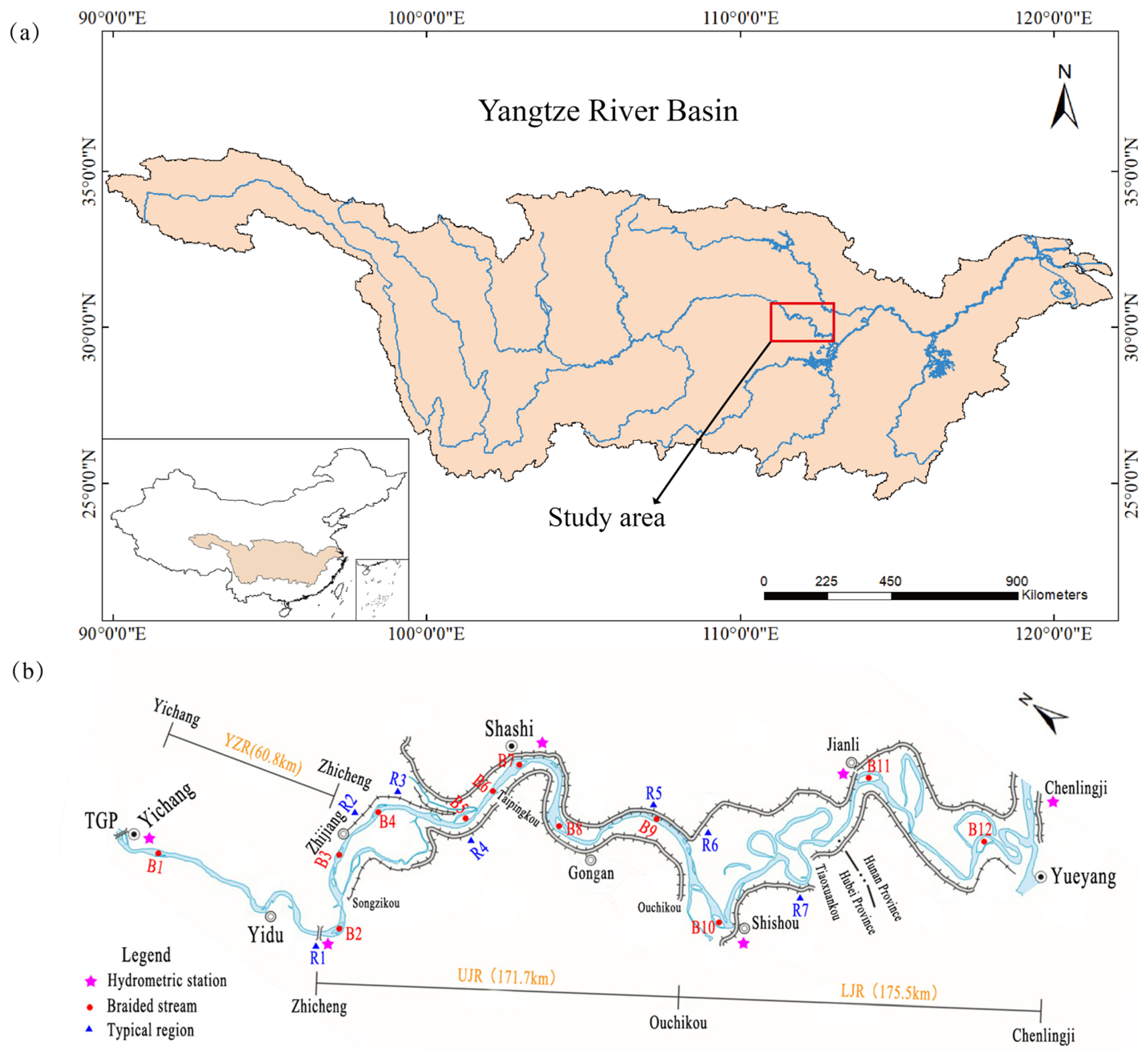

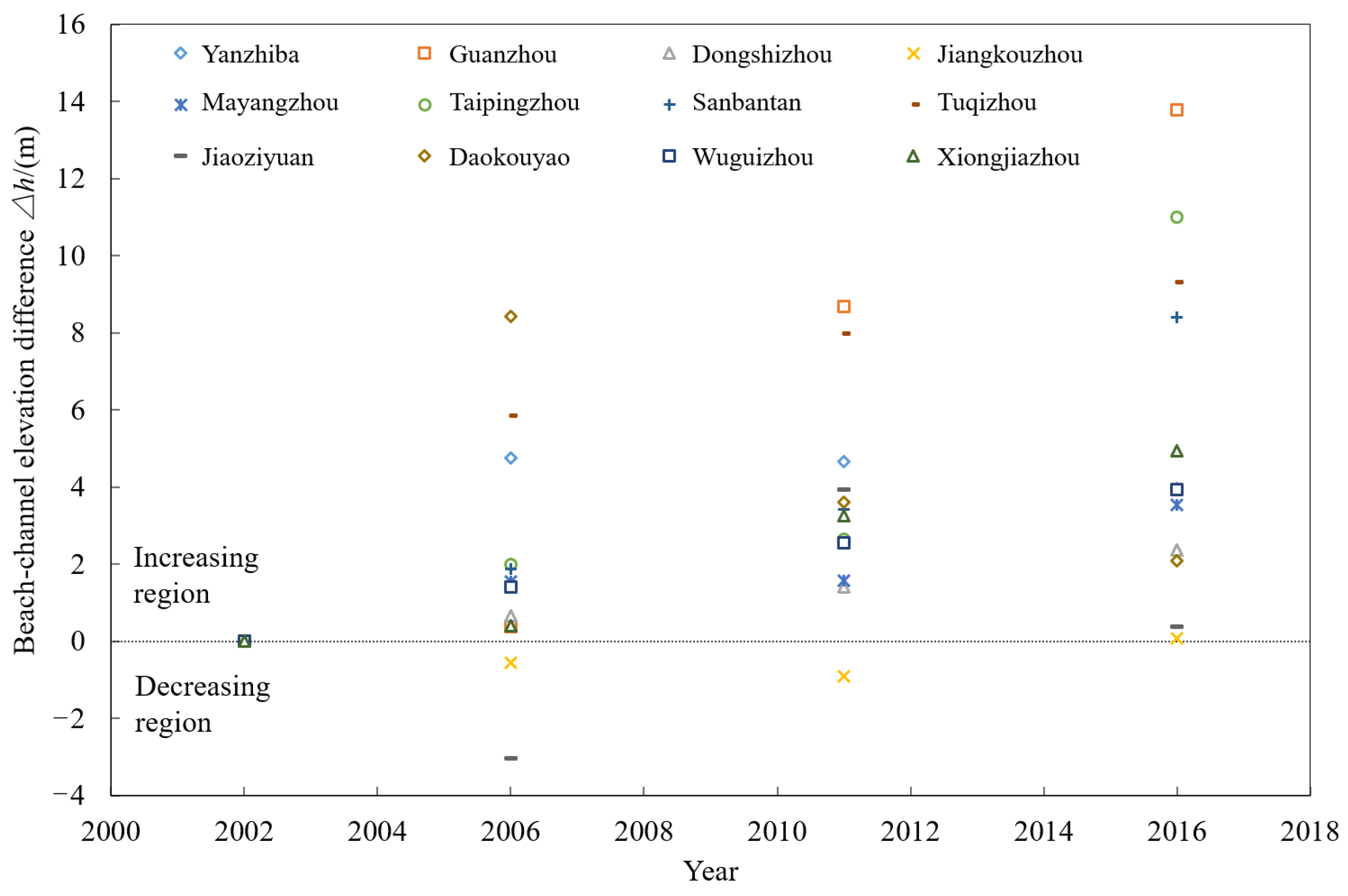

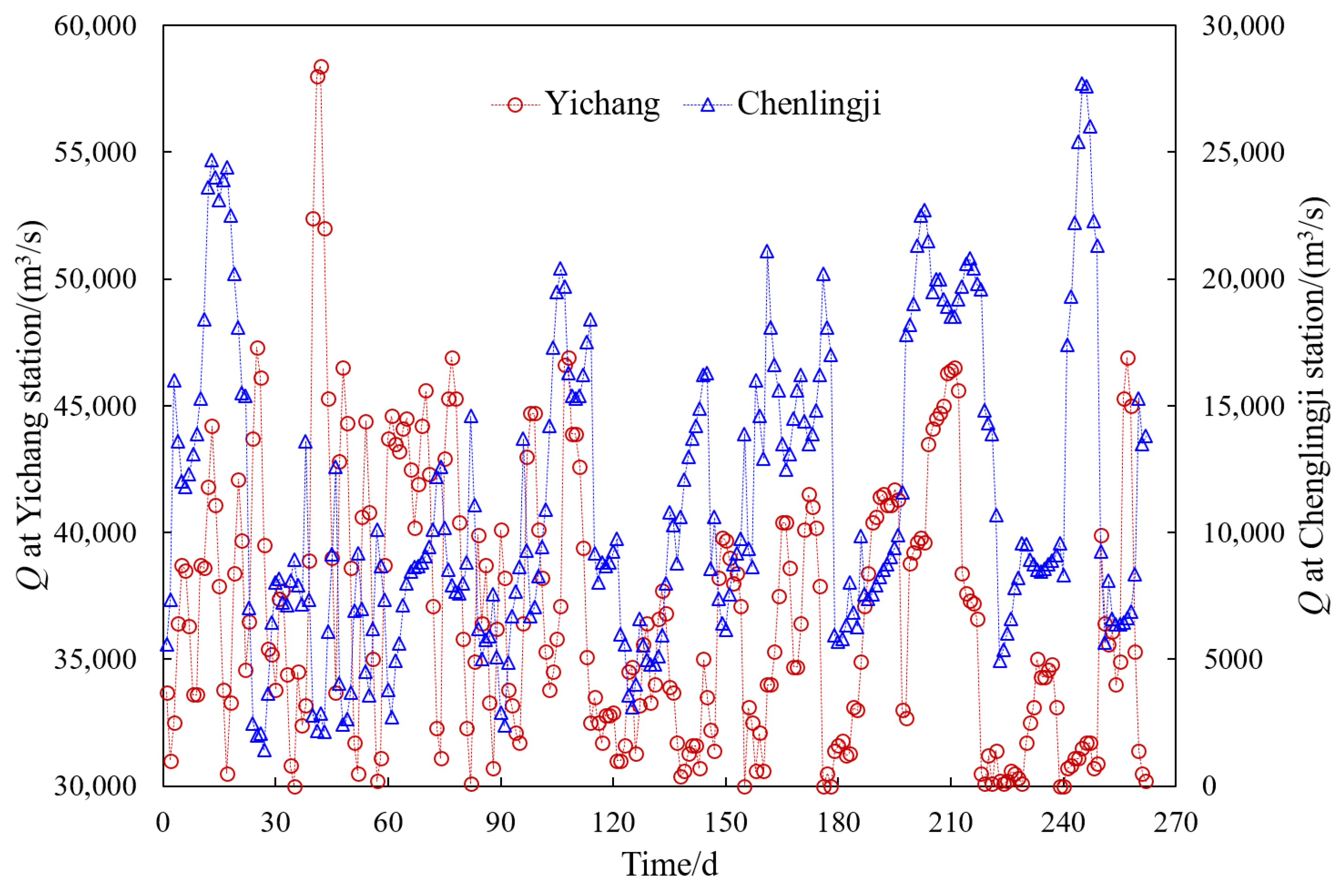


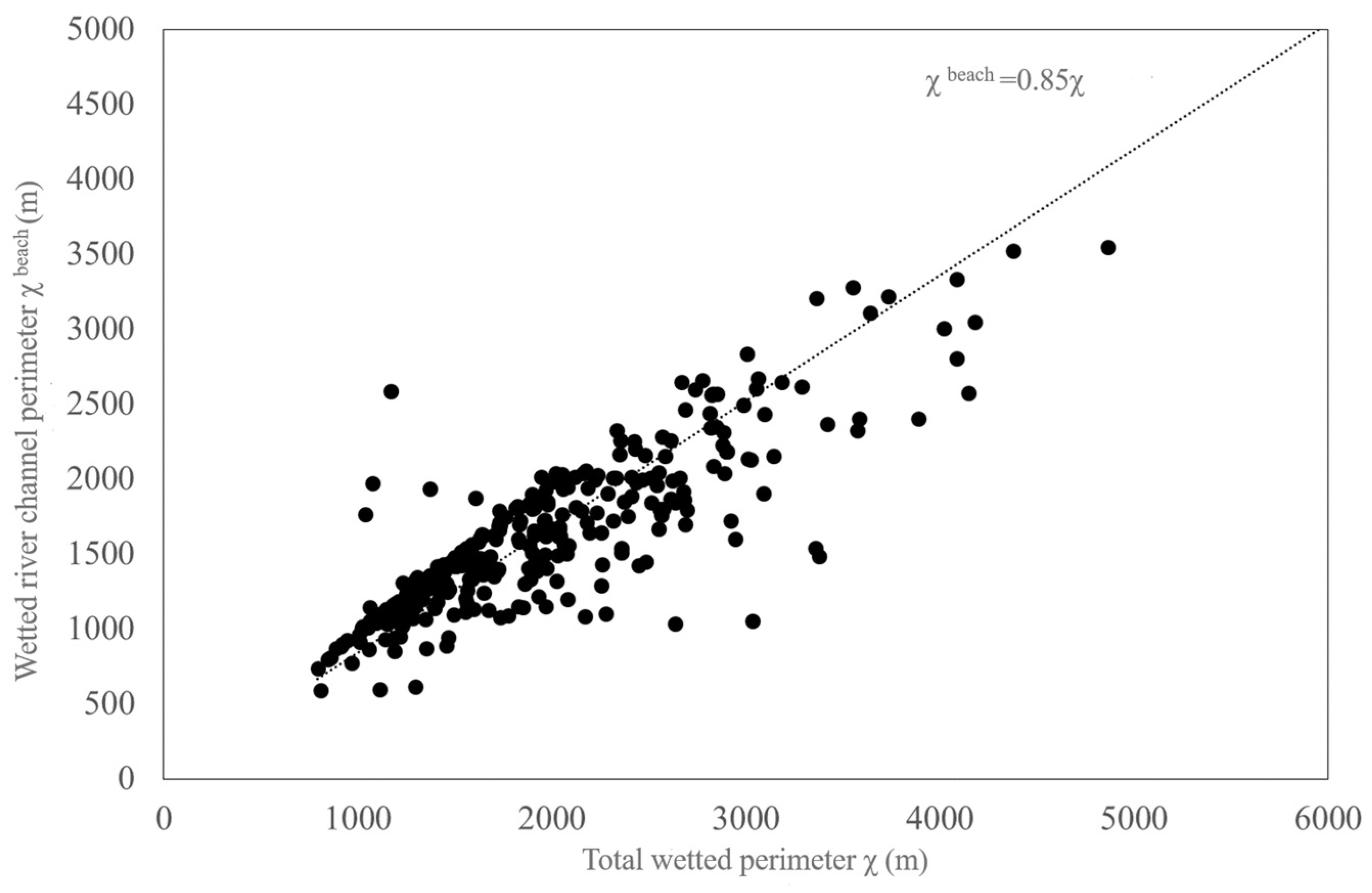
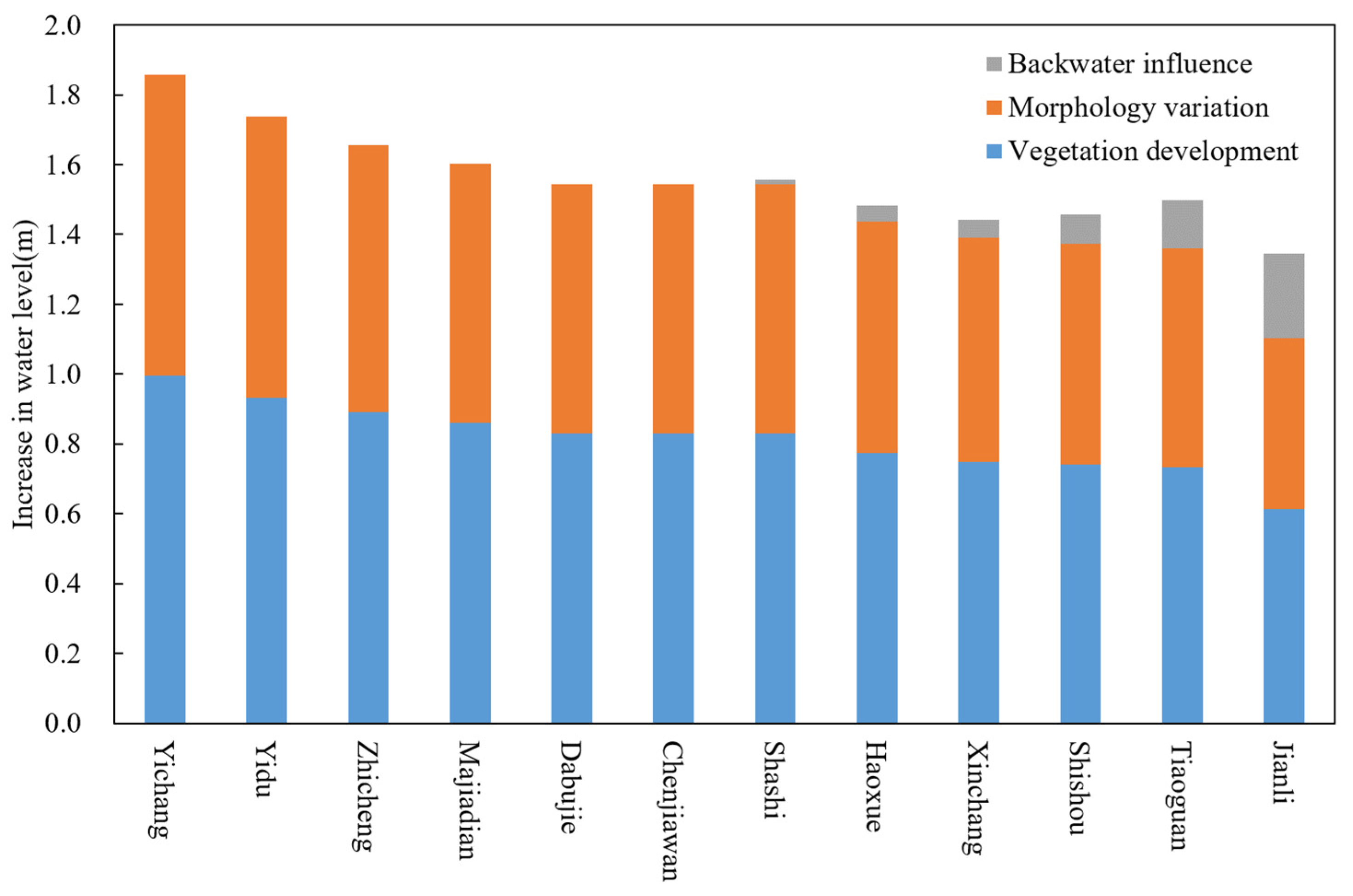

| Reach | Station | Location | Data Type |
|---|---|---|---|
| Yizhi Reach (YZR) | Yichang | 111.29° E, 30.69° N | Daily water level, discharge, and sediment |
| Zhicheng | 111.50° E, 30.30° N | ||
| Upper Jingjiang Reach (LJR) | Shashi | 112.26° E, 30.31° N | |
| Lower Jingjiang Reach (UJR) | Shishou | 112.33° E, 29.75° N | |
| Jianli | 112.90° E, 29.81° N | ||
| Chenglingji | 113.15° E, 29.44° N |
| Reach | Station | Relative Errors | |
|---|---|---|---|
| Calibration | Validation | ||
| YZR | Yichang | 7% | 5% |
| Zhicheng | −3% | −5% | |
| LJR | Shashi | 2% | 3% |
| UJR | Shishou | 6% | 4% |
| Jianli | 3% | −3% | |
| Chenlingji | −8% | −7% | |
Disclaimer/Publisher’s Note: The statements, opinions and data contained in all publications are solely those of the individual author(s) and contributor(s) and not of MDPI and/or the editor(s). MDPI and/or the editor(s) disclaim responsibility for any injury to people or property resulting from any ideas, methods, instructions or products referred to in the content. |
© 2024 by the authors. Licensee MDPI, Basel, Switzerland. This article is an open access article distributed under the terms and conditions of the Creative Commons Attribution (CC BY) license (https://creativecommons.org/licenses/by/4.0/).
Share and Cite
Jiang, L.; Zeng, Z. Analysis of Flood Water Level Variation in the Yichang–Chenglingji Reach of the Yangtze River after Three Gorges Project Operation. Water 2024, 16, 841. https://doi.org/10.3390/w16060841
Jiang L, Zeng Z. Analysis of Flood Water Level Variation in the Yichang–Chenglingji Reach of the Yangtze River after Three Gorges Project Operation. Water. 2024; 16(6):841. https://doi.org/10.3390/w16060841
Chicago/Turabian StyleJiang, Lei, and Ziyue Zeng. 2024. "Analysis of Flood Water Level Variation in the Yichang–Chenglingji Reach of the Yangtze River after Three Gorges Project Operation" Water 16, no. 6: 841. https://doi.org/10.3390/w16060841
APA StyleJiang, L., & Zeng, Z. (2024). Analysis of Flood Water Level Variation in the Yichang–Chenglingji Reach of the Yangtze River after Three Gorges Project Operation. Water, 16(6), 841. https://doi.org/10.3390/w16060841





